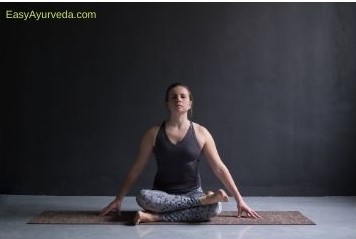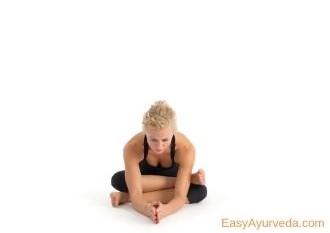Agnistambhasana – Fire Log Pose, How To Do, Benefits
By Dr Raghuram Y.S. MD (Ay) & Dr Manasa, B.A.M.S
Agnistambhasana, in this pose, the practitioner sits with crossed legs one on top of the other and tries to take a forward bend. This is an intermediate level sitting forward bend and is a great deep hip opener pose. This pose resembles sukhasana or padmasana.
Table of Contents
Meaning
Agnistambhasana
Agni = fire
Stambha = log
Asana = pose
By practicing this pose regularly and interlinking it with breathing techniques you can awaken the energy located in the pelvis and navel areas.
Why it is called as fire log pose?
- When the practitioner tries to bend forward with crossed legs it is said to cause a burning sensation in the hips as if there is a fire log therein and hence the name ‘fire log pose’. It is also called as ‘double pigeon pose’. It creates an intense heat in and around the groin and pelvic region.
- When in the final pose the two legs placed one on top of the other look like two fire logs placed one over the other and hence the name ‘fire log pose’. It is also called as burning log pose.
Read – Ardha Uttanasana – Standing Half Forward Bend Pose, Method, Benefits

Preparation
- Fire log pose should preferably done early morning on empty stomach.
- If it is practiced at any other time of the day, food should be consumed 3-4 hours before doing the asana.
- Keep the bowel and bladder empty while doing the pose.
Method of doing
Positioning for the pose
- Sit in Dandasana .
- Breathe easily and relax.
Performing the Pose
Bend left leg at the knee and place the foot / heel on the ground in front of you.
Now bend right leg and tuck it beneath the left leg. Right leg is exactly parallel to the edge of the mat.
Now lift left leg and place it right on top of right leg. Left foot / ankle is placed exactly on the right knee.
Adjust bottom leg (right) such that the right foot / ankle is placed exactly beneath left knee. Now legs are placed one over the other.
Keep the back straight and look straight.
Keep foot arches active and stabilize knees.
Keep hands with their fingertips touching the ground in front of your knees.
Walking your hands ahead gradually move forwards from pelvis / groins and take a forward bend. As you move forward make sure you keep your spine straight and don’t bend from the mid back. It should look like you are lengthening your spine from the crown of head.
Don’t forget to breathe in and breathe out as you move forward.
Go ahead into the bend as much as your body allows you to do.
At a point of maximum comfort stay for few breathes.
Release from the pose
- As you inhale slowly walk back on hands towards the body.
- Lift arms and place them on thighs.
- Release legs slowly and sit in staff pose.
- Breathe easily and relax.
- Repeat the same steps with the right leg on the top of left leg now.
Read – Tadasana – Mountain Pose: How To Do, Benefits, Side Effects
Variations
If it is difficult to place one leg over the other in the pose, you can just be at sukhasana – easy pose and take a bend.
If sitting in the final pose is difficult and if pelvis is moving backwards you can sit on a block. This will take pelvis higher than knees and you will be able to do the pose with much ease.
If the pose is difficult to do you may start with Baddha Konasana – bound angle pose and Supta Baddha Konasana – reclining bound angle pose. This will help you gain flexibility in hips so as to practice the fire log pose with ease.
Read – Ardha Baddha Konasana – Half Bound Angle Pose, How to do, Benefits

Related Video
Watch this video to follow the method of doing Agnistambhasana
https://www.youtube.com/watch?v=t3PUwVmiGr4
https://www.youtube.com/watch?v=rMfTHG6QeVE
Health Benefits
- It is one of the best deep hip openers
- Builds strength in lower body, outer hips and groins
- Stretches the hips, inner thighs, groins, gluteus, psoas, quads, hamstrings and ankles
- Increases flexibility to the muscles and tendons around groin
- Strengthens the legs and calves
- It stretches the piriformis muscle which cannot be reached since it is hidden amongst major muscles. This is one of the muscles that assist the hip rotation.
- When you lean forward in the pose abdominal muscles are massaged. When you come back at release there is a flushing effect in the entire digestive system.
- Stimulates the digestive and lymphatic systems
- Stimulates the immune system and enables its proper functioning
- Calms mind
- Helps reduce stress, anxiety and depression
Preparatory Poses
- Baddha Konasana – Bound Angle Pose
- Sukhasana – Easy Pose
Sequential Poses
- Padmasana – Lotus Pose
- Dirghasrngasana – Long Horn Pose
- Gomukhasana – Cow Face Pose
Counter Poses
- Bharadvajasana – Bharadvaja’s twist
- Paschimottanasana – Seated Forward Fold / Pose
- Setu Bandha Sarvangasana – Bridge Pose
Modifications
To create more space for hips, sit on folded blanket or block.
To ease the pressure on the knees if you are feeling any, place top leg in front of your bottom leg rather than on top of it.
To release pressure on bottom leg, use a block under the top ankle.
To help hips relax and also to relieve discomfort in the knee use a block under top knee.
Read – Mythology behind Agnistambhasana
Time spent
Be in the pose for 30-60 seconds. You need to perform the pose for the same duration even on the opposite side.
Impact on Chakras
This pose is said to open the root chakra. This provides mental and emotional grounding. Consequentially it increases one’s sense of security and peace. It also activates the Svadisthana Chakra – the sacral chakra and harmonizes the sacral energy center. By doing so it activates the intellectual power, creativity and emotional aspect. This will help you to develop good relationships with others.
Read – Chakra – Kundalini: Introduction, Meaning, Types, Location, Ayurveda View
Contraindications, Precautions
Patients suffering from below mentioned conditions should avoid doing Agnistambhasana –
- Knee injury
- Lower back injury
- Hip injury
- Those who have had recent hip or knee surgery
Caution
Those having tight hips or groin can use a block or bolster.
Impact on doshas and tissues
Impact on Doshas and its subtypes – Since it stimulates digestive system and imparts flushing effect on intestines, it helps in stimulating samana vata and apana vata. It calms the mind and reduces stress, anxiety and depression and hence it balances the axis of prana vata, sadhaka pitta and avalambaka kapha. It also balances the functions and energy of root and sacral chakras. Therefore the pose has a balancing effect on the lower intestines, kidneys and pelvic organs. This also happens due to apana vata balance brought about by balance of these chakras.
Impact on tissues – Since this pose stretches and strengthens the muscles and opens up the joints it is good for the health of muscles, joints and bones.
Click to Consult Dr Raghuram Y.S. MD (Ayu)









